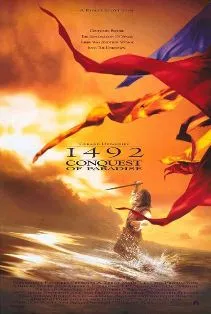Historical accuracy of 1492: Conquest of Paradise

Historical accuracy of 1492: Conquest of Paradise

Characters
Christopher Columbus
While the film depicts Columbus's voyages and ambition, it simplifies the complexities of his character and the historical context. It downplays the darker aspects of his actions and the impact on indigenous populations.
Queen Isabella I of Castile
Isabella's role in financing Columbus's voyage is accurate. However, the film's portrayal of her motivations and the political climate of the time is somewhat romanticized.
King Ferdinand II of Aragon
Similar to Isabella, Ferdinand's involvement is historically accurate, but the film simplifies his political motivations and the intricacies of the Spanish court.
Martín Alonso Pinzón
Pinzón's role in the voyage is historically documented. However, the film's portrayal of his relationship with Columbus and his motivations is somewhat dramatized.
Bartolomé de las Casas
Bartolomé de las Casas was a real historical figure who did accompany later voyages and became a vocal advocate for indigenous rights. However, his presence and actions in the film's timeframe are somewhat compressed and dramatized.
Chief Guacanagarix
Guacanagarix was a real Taíno chief who interacted with Columbus. The film's portrayal of his interactions and motivations is based on historical accounts, but these accounts are limited and often biased.
More characters
Adrián de Moxica
Adrián de Moxica was a real historical figure, but the movie shows him being executed early in the colonization. In actuality, he was executed years later, after Columbus was removed from power. The movie uses this character to demonstrate the lawlessness of the early colony, but it is not historically accurate.
Story
Columbus's goal: prove Earth is round
By the 15th century, most educated Europeans knew the Earth was round. Columbus aimed to find a westward route to the East Indies.
Voyage funded by Queen Isabella
While Queen Isabella supported the voyage, funding came from various sources, including Italian investors.
Mutiny on the voyage
Sailors were anxious about the long journey and lack of landfall, leading to unrest. However, the film dramatizes this.
Landing in the Bahamas
Columbus first landed in the Bahamas, though the exact island is debated. The film depicts this accurately.
Encountering peaceful natives
Initial encounters were likely peaceful, but the film romanticizes the indigenous people and downplays later conflicts and exploitation.
Columbus's respectful attitude
Historical accounts vary on Columbus's treatment of indigenous people. The film portrays him more sympathetically than some accounts suggest.
Gold obsession depicted
While the search for gold was a motive, the film oversimplifies the complex economic and religious factors driving exploration.
Columbus's governorship
Columbus was appointed governor of Hispaniola, but his rule was marked by brutality and mismanagement, which the film downplays.
Return to Spain in chains
Columbus was arrested and returned to Spain in chains due to complaints about his governance. The film depicts this accurately.
Legacy of brutality glossed over
The film minimizes the violence, enslavement, and exploitation inflicted on indigenous people under Columbus's rule.
Setting
Navigation methods shown
The film shows some navigational tools of the time, but simplifies the challenges and uncertainties of open-ocean voyages.
Depiction of indigenous culture
While visually impressive, the film's portrayal of indigenous culture is romanticized and lacks nuance.
Spread of disease
European diseases devastated indigenous populations, though the film doesn't fully show the scale of this tragedy.
Overall
Overall historical accuracy
1492' offers a visually appealing but sanitized version of Columbus's voyages, omitting or downplaying the darker aspects of his legacy.
